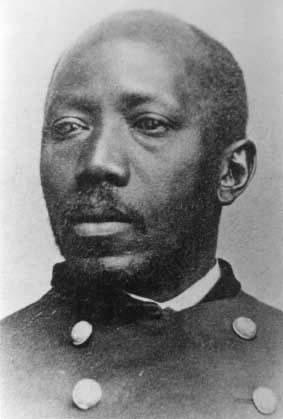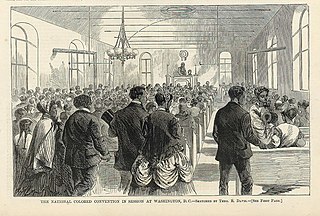
Martin Robison Delany was an American abolitionist, journalist, physician, military officer and writer who was arguably the first proponent of black nationalism. Delany is credited with the Pan-African slogan of "Africa for Africans." Born as a free person of color in Charles Town, Virginia, now West Virginia, and raised in Chambersburg and Pittsburgh, Pennsylvania, Delany trained as a physician's assistant. During the cholera epidemics of 1833 and 1854 in Pittsburgh, Delany treated patients, even though many doctors and residents fled the city out of fear of contamination. In this period, people did not know how the disease was transmitted.

Lewis Woodson was an educator, minister, writer, and abolitionist. He was an early leader in the African Methodist Episcopal Church (AME) in Ohio and Pennsylvania. Woodson started and helped to build other institutions within the free African-American communities in Ohio and western Pennsylvania prior to the American Civil War.

King Solomon "Sol" White was an American professional baseball infielder, manager and executive, and one of the pioneers of the Negro leagues. An active sportswriter for many years, he wrote the first definitive history of black baseball in 1907. He was elected to the Baseball Hall of Fame in 2006.

Octavius Valentine Catto was an American educator, intellectual, and civil rights activist. He became principal of male students at the Institute for Colored Youth, where he had also been educated. Born free in Charleston, South Carolina, in a prominent mixed-race family, he moved north as a boy with his family. After completing his education, he went into teaching, and becoming active in civil rights. He also became known as a top cricket and baseball player in 19th-century Philadelphia, Pennsylvania. A Republican, he was shot and killed in election-day violence in Philadelphia, where ethnic Irish of the Democratic Party, who were anti-Reconstruction and had opposed black suffrage, attacked black men to prevent their voting.
The National Equal Rights League (NERL) is the oldest nationwide human rights organization in the United States. It was founded in Syracuse, New York in 1864 dedicated to the liberation of black people in the United States. Its origins can be traced back to the emancipation of slaves in the British West Indies in 1833. The league emphasized moral reform and self-help, aiming "to encourage sound morality, education, temperance, frugality, industry, and promote everything that pertains to a well-ordered and dignified life." Black leaders formed state and local branches of the league which drew many members, which caused the society to grow quickly, in areas such as Harrisburg, Pennsylvania, where people such as Thomas Morris Chester joined.
The civil rights movement (1865-1896) aimed to eliminate racial discrimination against African Americans, improve their educational and employment opportunities, and establish their electoral power, just after the abolition of slavery in the United States. The period from 1865 to 1895 saw a tremendous change in the fortunes of the black community following the elimination of slavery in the South.

David Bustill Bowser was a 19th-century African-American ornamental artist and portraitist. As the designer of battle flags for eleven African-American regiments during the American Civil War and painter of portraits of prominent Americans, including U.S. President Abraham Lincoln and abolitionist John Brown, Bowser was an artist whose "works were the first widely viewed, positive images of African Americans painted by an African American," according to historians at the Pennsylvania Historical and Museum Commission. Politically active throughout much of his adult life, he also helped to secure the post-war passage of key civil rights legislation in Pennsylvania.

The Philadelphia Pythians was one of the earliest Negro league baseball clubs, founded in 1865. African-American leaders Jacob C. White Jr. and Octavius V. Catto established the team. The Pythians were composed of primarily business and middle class professionals from the surrounding areas of Washington, D.C., Philadelphia, and New York City. Just two years after the Civil War ended, in 1867, the Pennsylvania State Convention of Baseball, located in Harrisburg, denied the "Pythian Base Ball Club" out of Philadelphia. The team dissolved after Catto's death in 1871 and a new team formed under the Pythian name in the National Colored Base Ball League in 1887. The new team's first season went 4–1. However, due to financial troubles, the team folded after only one season.
The following is a timeline of the history of the city of Philadelphia, Pennsylvania.

The Colored Conventions Movement, or Black Conventions Movement, was a series of national, regional, and state conventions held irregularly during the decades preceding and following the American Civil War. The delegates who attended these conventions consisted of both free and formerly enslaved African Americans, including religious leaders, businessmen, politicians, writers, publishers, editors, and abolitionists. The conventions provided "an organizational structure through which black men could maintain a distinct black leadership and pursue black abolitionist goals." Colored conventions occurred in thirty-one states across the United States and in Ontario, Canada. The movement involved more than five thousand delegates and tens of thousands of attendees.

John C. Bowers was an African American entrepreneur, organist and vestryman at St. Thomas African Episcopal Church, and a founding member of the first Grand United Order of Odd Fellows for African Americans in Pennsylvania. He was active in the anti-slavery movement in Philadelphia, and involved in the founding of several organizations including the Pennsylvania Anti-Slavery Society. "A fervent abolitionist and outspoken opponent of colonization, [he] was much in demand as a public speaker."
Zedekiah Johnson Purnell (1813–1882) was an African-American activist, businessman, and editor. He served as the editor of the literary journal The Demosthenian Shield. In the 1840s, Purnell emerged on the national stage as an outspoken proponent of an African-American press, supporting such authors as Charles Bennett Ray and Samuel Cornish.
James George Barbadoes was an African-American, community leader, and abolitionist in Boston, Massachusetts in the early 19th century. Dedicated to improving the lives of people of color at the local level, as well as the national level.
This was the first meeting of the Pennsylvania State Equal Rights League, which was a civil rights organization formed to promote equal rights for African American citizens of the state. The Pennsylvania State Equal Rights League was part of a nationwide movement to promote legal and political rights for black Americans.

Hezekiah Grice was an American and Haitian activist, machinist, and businessman, noted for his political activity in Baltimore during the early 19th century. While working as a machinist in Baltimore, he was either the first person or one of the first people to suggest holding a National Negro Convention to discuss the possibility of mass emigration by African Americans away from the United States. This was the beginning of the Colored Conventions Movement. Grice was also a leading figure in the founding of the Legal Rights Association, which has been credited with helping to clarify citizenship rights in America, as well as with pioneering several important tactics in American civil rights activism. He later moved to Haiti where he could secure full citizenship rights. There he became a prominent tradesman and a confidant of Faustin Soulouque.

This is a timeline of women's suffrage in Pennsylvania. Activists in the state began working towards women's rights in the early 1850s, when two women's rights conventions discussed women's suffrage. A statewide group, the Pennsylvania Woman Suffrage Association (PWSA), was formed in 1869. Other regional groups were formed throughout the state over the years. Suffragists in Pittsburgh created the "Pittsburgh Plan" in 1911. In 1915, a campaign to influence voters to support women's suffrage on the November 2 referendum took place. Despite these efforts, the referendum failed. On June 24, 1919, Pennsylvania became the seventh state to ratify the Nineteenth Amendment. Pennsylvania women voted for the first time on November 2, 1920.

Women's suffrage in Pennsylvania was an outgrowth of the abolitionist movement in the state. Early women's suffrage advocates in Pennsylvania not only wanted equal suffrage for white women, but for all African Americans. The first women's rights convention in the state was organized by Quakers and held in Chester County in 1852. Philadelphia would host the fifth National Women's Rights Convention in 1854. Later years saw suffragists forming a statewide group, the Pennsylvania Woman Suffrage Association (PWSA), and other smaller groups throughout the state. Early efforts moved slowly, but steadily, with suffragists raising awareness and winning endorsements from labor unions.
Rev. John E. Price was an elder and minister of the African Methodist Episcopal Zion Church. He was a minister for around 50 years. He was the founder and president of the Garnet Equal Rights League at Harrisburg. He wrote hymns and was an editor for the Zion Church Advocate and, with William H. Day, the Zion Church Herald and Outlook, the first paper of the AME Zion Church. Day was a minister, abolitionist, and educator.

The California State Convention of Colored Citizens (CSCCC) was a series of colored convention events active from 1855 to 1902. The convention was one of several social movement conventions that took place in the mid-19th century in many states across the United States.
Joseph Cassey (1789–1848) was a French West Indies-born American businessman, real estate investor, abolitionist, and activist. He prospered as a barber, and as well as a wig maker, perfumer, and money-lender. He lived in the historic Cassey House in Society Hill, and was active in the African American elite community in Philadelphia.











